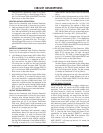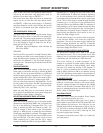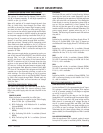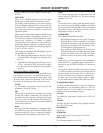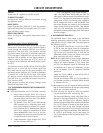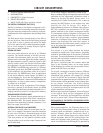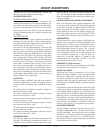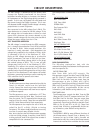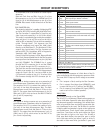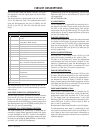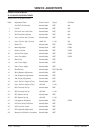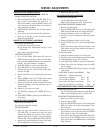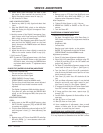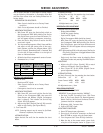
CIRCUIT DESCRIPTIONS
PV154 - 923-03506 3-12 ZP26/28 - SERVICING
The ABL voltage is determined by the current draw
through the Flyback transformer. As the picture
brightness becomes brighter or increases, the demand
for replacement of the High Voltage being consumed is
greater. In this case, the flyback will work harder and
the current through the Flyback increases. This in turn
will decrease the ABL voltage. The ABL voltage is inversely
proportionate to screen brightness.
Also connected to the ABL voltage line is DH16. This
zener diode acts as a clamp for the ABL voltage. If the
ABL voltage tries to increase above 11V due to a dark
scene which decreases the current demand on the
flyback, the ABL voltage will rise to the point that DH16
dumps the excess voltage into the 11 line.
ACCL TRANSISTOR OPERATION
The ABL voltage is routed through the PSD2 connector
pin 2, through the acceleration circuit RC62 and DC02
to the base of QX18. Under normal conditions, this
transistor is nearly saturated. QX18 determines the
voltage being supplied to the cathode of DC01, which
is connected to pin 53 of the Rainforest IC, IC01.
During an ABL voltage decrease due to an excessive
bright circumstance, the base of QX18 will go down,
this will drop the emitter voltage which in turn drops
the cathode voltage of DC01. This in turn will pull
voltage away from pin 53 of the Rainforest IC, IC01.
Internally, this reduces the contrast and brightness
voltage which is being controlled by the I
2
C bus data
communication from the Microprocessor arriving at pins
30 and 31 of the Rainforest IC and reduces the overall
brightness, preventing blooming as well as reducing the
Color saturation level to prevent color smear.
MAIN MICROPROCESSOR
OVERVIEW
The Microprocessor must keep communication with the
Chassis to maintain control over the individual
circuits. Some of the circuits must return information
as well so the Microprocessor will know how to respond
to different requests.
The Microprocessor uses a combination of I
2
C Bus
communication and the Serial Data, Clock and Load
lines for control. The I
2
C communication scheme only
requires 2 lines for control. These lines are called SDA
and SCL. Serial Data and Serial Clock respectively.
The Microprocessor also requires the use of what are
called Fan Out IC or DACs, (Digital to Analog
Converters). This allows the Microprocessor to use only
two lines to control many different circuits.
Also, due to the fact that this Microprocessor operates
at the new 3.3Vdc voltage, it requires a Level Shift IC
to bring up the DC level of the control lines to make it
compatible with the connected ICs.
The Microprocessor communicates with the following
ICs:
ON THE SIGNAL PWB
Main Tuner U501
PinP Tuner U502
EEPROM I002
Flex Converter I301
DAC1 I006
DAC3 I007
Level Shift I004
3D Y/C I301
Main Video Chroma I501
Rainforest IC01
ON THE TERMINAL PWB
A/V Selector IX01
Sub Video Chroma IX03
Main Y Pr/Pb Selector IX04
Sub Y Pr/Pb Selector IX05
ON THE SURROUND PWB
Front Audio Control IA01
DATA COMMUNICATION
The following explanations deal with the
communication paths used between the Microprocessor
and the respective ICs.
ON THE SIGNAL PWB
Main Tuner U501 (with MTS outputs). The
Microprocessor controls the Main Tuner by SDA (Data)
and SCL (Clock) I
2
C communication lines. SCL1 and
SDA1 lines for the Main Tuner are output from the
Microprocessor at pins 2 (SDA1) and 3 (SCL1)
respectively. These lines go directly to the Main Tuner,
SDA1 at pin (5) and SCL1 at pin (4). These lines control
band switching, programmable divider set-up
information, pulse swallow tuning selection, etc.
PINP TUNER U502
The Microprocessor controls the Main Tuner by SDA
(Data) and SCL (Clock) I
2
C communication lines. SCL1
and SDA1 lines for the Main Tuner are output from
the Microprocessor at pins (2 SDA1 and 3 SCL1)
respectively. These lines go directly to the Main Tuner,
SDA1 at pin (5) and SCL1 at pin (4). These lines
control band switching, programmable divider set-
up information, pulse swallow tuning selection.
EEPROM I003
The EEPROM is ROM for many different functions of
the Microprocessor. Channel Scan or Memory List,
Customer set ups for Video, Audio, Surround are
memorized as well. Also, some of the Microprocessors
internal sub routines have variables that are stored



